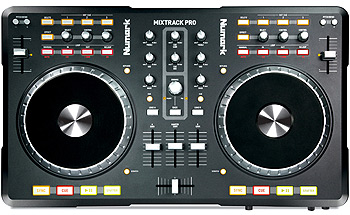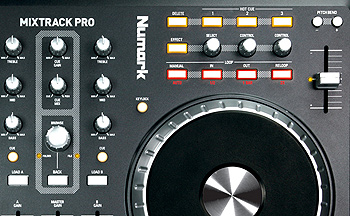Numark Mixtrack Pro Review – Part One

This is the top of two DJ units bearing the Numark Mixtrack name – this ‘Pro’ model is identical to the standard model aside from the fact that the more expensive ‘Pro’ has a built-in souncard and works with Virtual DJ LE (as opposed to the standard Mixtrack, which uses [free] Traktor LE).
Build Quality
At just over 18″ wide and 11″ deep, the unit itself is extremely lightweight and portable, easily fitting into a decent sized laptop bag or backpack. Although having a body that seems fully formed in plastic, it still feels quite strong and durable for project studio and live club operation. The mini-platters, emulating a standard CDJ format, sit left and right, with the mixer controls central. Transport controls, looping, cue and all other essentials are logically laid out too. So lets have a look round the hardware side of things and gauge the type of quality in relation to the affordable price bracket it sits in.
Response
One of the most important features of any DJ controller is the tactile response of all controls – platters, faders, buttons and knobs etc. Although not falling into the ultra-pro end ‘feel’ of Numark’s rather more more expensive (and user configurable), NS7/V7 etc, the Mixtrack Pro delivers a non-adjustable, middle-ground response that Numark have bestowed on the platters. This works fine for me, combining a good ratio between free running and resistance factors. The vertical track faders seem a little stiff however (and can slightly ‘shake’ the unit if used vigorously), but once you get used to them, quite honestly, they’re fine. As for the rest of the Mixtrack’s faders, dials and buttons, all feel and operate at a high quality representation, again considering that this is a more ‘budget’ of Pro solutions.
 Navigate and Load
Navigate and Load
Navigating around playlists and selecting/loading of tracks is a breeze with Mixtrack Pro addressing the Virtual DJ LE software. The central scrollable dial uses a ‘back’ button and a click me feature to navigate through hard disc folders and songs, loading whichever selection the DJ chooses quickly and with no fuss. Be aware though (and this may be something that could be avoided by upgrading to the Virtual DJ ‘full’ pro version), that it’s easy to load up a new track over the top of (and replacing) a ‘live’ one already playing. An alternative provided too by the way are the two separate ‘Load A/B’ buttons which provide the same (deck loading function).
Check The Mix
Standard and important DJ controls of headphone ‘cue’s (selectable between cue channel and program mix), headphone level and 3 band EQ are present and correct. The headphone gain sounded perhaps not quite loud enough for me with a dial that seemed to max out before reaching it’s full rotation potential. The three band (bass, mid, treble) EQ are full ‘kill’ featured and sound pretty decent, again for such an affordable piece of DJ hardware.
One major gripe for me though personally has to be the lack of individual channel ‘gain’ controls, essential I think for any DJing solution these days. The only way to affect the overall unity volume level needed when prepping a mix then is to reach over to your computer mouse etc and adjust on the software’s interface. This one drawback could be a deal-breaker for some, but in fairness, not to all user/DJs who may be happy just slightly adjusting the track level faders accordingly to compensate.
 Plug and Play
Plug and Play
Checking out the Numark Mixtrack Pro’s connectivity attributes sees the rear panel holding the class compliant USB connection (no drivers necessary) and two sets of stereo, phono connectors. One set is for the main ‘master’ outputs to a club/studio system, and the second, bizarrely enough, are outputs which send out the unit’s (headphone) ‘cue’ signal. Now I can see perhaps the sense in this second set of phono outs duplicating the master outs for maybe a separate ‘monitor’ feed, but why on earth would a DJ need to hear an amplified version of the headphone output? – your thoughts on this dear reader would be appreciated below. Spinning her around, the front panel houses the Mixtrack Pro headphone and microphone connections (both 1/4″ jack) plus a ‘Mic Gain’ dial which sends the signal direct into the master mix (no EQ available though I’m afraid).
Creative Tools
Finishing off this first part review of the Mixtrack Pro and moving back to the top panel work area, the upper left and right accommodates the creative area of getting in the mix with 3 assignable hot-cues, manual and auto-looping options and a basic, but useful, effects control section too. Right next to these are the obligatory pitch sliders and ‘plus/minus’ tempo nudge buttons – always handy.
In the next, part two of this Numark Mixtrack Pro review, I’ll be looking at the unit’s hot-cue, looping and effects capabilities and how it actually performs and operates in full-on DJ mixing mode – with one eye on the Virtual DJ LE software too. Until then.


